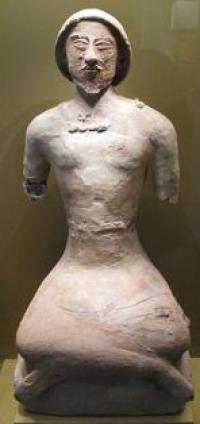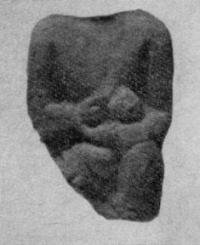You are here
Fortress Koy-Krylgan kala.


Tour to Karakalpakia.
“This fortress (as we later learned - it was Koy-Krylgan-kala) was not visible from the tower of the Teshik-kala castle. The dilapidated walls of the eighteen-sided citadel were surrounded by a regular circle of an almost-leveled outer wall with the remains of nine towers.
The edges of the citadel walls, made of huge square mud bricks, which rose in places by 5-6 meters, were cut by narrow and frequent slots of loopholes, arrow-shaped from above by pairs of bricks converging at an acute angle.
And inside and around the citadel lay countless fragments of vessels of excellent workmanship and firing, with a surface either covered with red lacquer, or decorated with cut-out ornamentation in the form of corners and triangles, followed by red, brown and black painting on a pinkish-yellow background. Among the shards we raised a bronze two-pointed arrowhead of the Early Scythian type and a pair of terracotta figurines - a headless figure of a man sitting with one knee tucked under him and resting his hand on the other, and an image of a woman sitting with her legs down to one side on the back of a fantastic beast."
Tolstov S.P. "In the footsteps of the ancient Khorezm civilization."
Walking along architectural monuments of Karkalpakstan.
The Koy-Krylgan kala fortress is located on a natural hill 100.6 meters above sea level, in the northern part of the Kyzylkum desert, 17.7 kilometers southeast of the village of Ellikala, 17.4 kilometers southwest of the village of Jumbaskala, 31.3 kilometers to the east and slightly north of the city of Beruni in the Ellikala region of the Republic of Karakalpakstan.
The ruins of thousands of fortresses are scattered across the endless expanses of the Khorezm steppes, but the ruins of the Fortress of Perished Sheep - Koy-Krylgan-kala are truly unique. The fortress was found by archaeologists of the Khorezm expedition by chance in 1938.
In 1950, a new stage of excavations began on the ruins of the fortress. As a result, it became clear that the fortress went through two stages of its development. An earlier stage dates back to the IVth - IIIrd centuries BC. The second era of the fortress's life dates back to the first centuries AD.
It was discovered that in the early stages of development, the central part of the fortress was destroyed by fire. It still remains a mystery whether it was accidental or deliberate. The remarkable monument of Khorezm antiquity - Koy-Krylgan-kala (Fortress of the Dead Sheep) is marked by the high art of ancient masters.
The temple of the funeral and astral cults of Koy-Krylgan kala existed for several centuries from the 4th century BC. to III - IV century AD The central building of the Koi-Krylgan kala is a round, monumental structure crowned with a gallery with a number of rifle loopholes.
The diameter of the building at the base was 44.5 meters, the thickness of the walls was from 7 to 6 meters. The walls are made of pakhsa and adobe bricks. The premises form a cruciform figure in the plan. All eight rooms on the ground floor were covered with double vaults.
They were intended, apparently, for special cult purposes, and in the upper rooms were placed stores of supplies of temple food or sacrificial food, temple utensils, terracotta images of deities were kept and, apparently, cult ceremonies were held.
Small cult terracottas, miniature vessels, rhytons, ceramics decorated with mythological subjects - all this found here is characteristic of burial items. The building itself was surrounded by a double ring of fortress walls, with towers built between the walls of the corridor.
Two towers had internal, almost square chambers, fenced off from the corridor by blank walls of mud brick 1 meter thick, so that one could get inside the towers only with the help of ladders. From the courtyard, loopholes opened into the towers.
As a result of the excavations of Koy-Krylgan-kala, two main periods of its existence were established, separated from each other by significant periods of time. The purpose of the monument in each period was different, which was reflected in the nature of the finds, the use of premises, etc.
At the beginning of the new era, this high-rise palace was an observatory, a kind of astronomical center of Khorezm. An astrolabe was found here, a goniometric instrument, with the help of which observations of the sun and other luminaries were also carried out here.
Finds of terracotta images of deities and statuary ossuaries (Ossuary is an earthen box, an ossuary where, according to the Zoroastrian ritual, the bones of the dead were cleared of external integuments; the ossuary was crowned with an image of a human figure), as well as an analysis of the plan of the central building, allow us to conclude that Anahita was revered here and Siyavush are the most popular deities of Ancient Khorezm.
In equal reverence for the sun and the water element personified by the ancient Khorezmians, researchers are looking for a solution to the layout of the Koy-Krylgan kala, which is based on solar symbols - a circle and a cross.
Statuary ossuaries, depicting figures of female and male deities, in which the worship of the population of deceased ancestors was embodied, are remarkable monuments of ancient Khorezm art. Figures, sometimes made almost in full size, realistically convey the anthropological type of people, their clothes, hats.
The appearance in Khorezm of ossuaries in the form of ancient statues testifies to the preservation of traditions. At Koi-Krylgan kala, fragments of about 10 ceramic burial statues were found, which, differing in size, conveyed the image of the same type.
So, all female images are the appearance of a young woman sitting in a static, solemn pose. Sometimes the legs of thrones are depicted on ossuaries, devices are made for installing small canopies. The funerary sculptures are stylistically similar to statuettes, which are reputedly depicting deities.
Scientists believe that statuary ossuaries depicted the dead, embodied in the guise of a chthonic deity, most likely Ardvisura Anahita, convey an image that is part of the circle of ideas about the great goddess, the mother of all living, the mistress of the kingdom of the dead.
Statue ossuaries have also been found depicting a seated man. Perhaps they convey the image of Siyavush, the god of a dying and resurrected nature, closely associated with the cult of the dead. There were ossuaries that reproduced monumental buildings. In the ruins of Koi-Krylgan kala 2 (located a few tens of meters from the main monument), an ossuary was found resembling a building, rectangular, with slightly rounded walls diverging upward, imitating a tent.
Perhaps the ossuary reproduced the appearance of the tent, which was erected during the funeral rite at an earlier time. The immediate prototype of this form could serve as crypt buildings. The spread of this Zoroastrian burial rite with the belief system of the Zoroastrian circle, the veneration of the cult of ancestors was so widespread that the remains of statuary ossuaries were found on the ruins of many rural dwellings of the era in question.
Almost in every such dwelling there was a room like a home prayer room, intended for the performance of rituals of worshiping ancestors in front of the statuary ossuaries that stood there. Terracotta figurines of gods and goddesses worshiped by the ancient Khorezmians were made with no less art than ossuaries.
Among them is the already mentioned Anahita - the Great Mother Goddess, usually depicted wearing a dress that is wide with many folds. Figures of horses symbolized the solar deity Mitra or Siyavush. Finds of images of the god Dionysus in the form of a naked man with a grape bunch in one hand and a crooked garden knife in the other remind of another cult - Bacchus, which also took place at that time.
The idea of the level of development of art in Khorezm IV - III centuries. BC. and a few later times are supplemented by the finds of magnificent ceramic flasks with relief images of hunting scenes, court life, characters of ancient Khorezm mythology or the epic "tree of life" with deer.
The plots of images on clay and stone seals have something in common with motifs of Scythian art of the same or somewhat earlier period. These include images of a vulture, a bird or deer in a flying gallop, etc. About the high level of culture of Khorezm in the middle of the 1st millennium BC evidenced by the development of writing using the Aramaic script.
The earliest documents of this writing in the ancient Khorezm language were found during excavations of the Koy-Krylgan kala and are dated to the IIIrd - IInd centuries. BC. The inscriptions were made in ink or with a sharp instrument on the vessels and terracotta.
One of them, scribbled on the wall of the hum, reads “Aspabarak” or “Aspabadak” (“Riding on a horse”).
Geographic coordinates of the Koy-Krylgan kala fortress: N41 ° 45'19.74 "E61 ° 07'00.77"
Authority:
http://sovminrk.gov.uz







